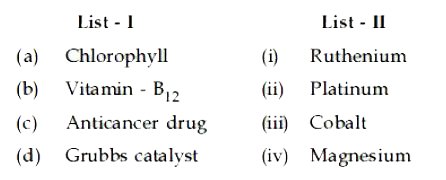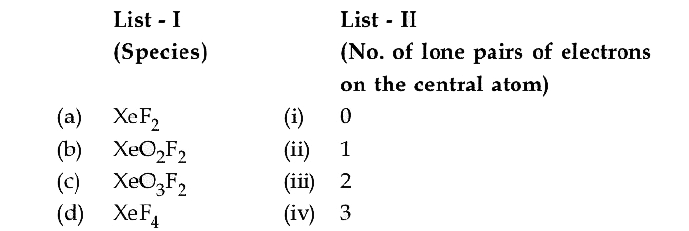Given below are two statements:
Statement I: Lithium and magnesium do not from superoxide
The ionic radius of Li+ is larger than ionic radius of Mg2+
In the light of the above statements, choose the most appropriate answer from the options given bleow :
Both Statement I and Statement II are Incorrect
Both Statement Iand Statement II are correct
Statement I is incorrect but Statement II is correct
Statement I is correct but Statement II is incorrect
The correct Answer is:B
To solve the question, we will analyze both statements provided and determine their correctness.
1. Analyzing Statement I:
- Statement: Lithium and magnesium do not form superoxide.
- Explanation: Superoxides are compounds that contain the superoxide ion (O₂⁻). The formation of superoxides typically requires a larger cation that can stabilize the larger superoxide ion. Lithium (Li) and magnesium (Mg) have relatively small ionic sizes. Because of their small size, they cannot accommodate the larger superoxide ion effectively. Therefore, this statement is correct.
2. Analyzing Statement II:
- Statement: The ionic radius of Li⁺ is larger than the ionic radius of Mg²⁺.
- Explanation: The ionic radius of an ion is influenced by its charge and the number of protons in the nucleus. Li⁺ has a single positive charge and fewer protons compared to Mg²⁺, which has a double positive charge (due to the loss of two electrons). The increased positive charge in Mg²⁺ results in a stronger attraction between the nucleus and the remaining electrons, leading to a smaller ionic radius. Therefore, the ionic radius of Li⁺ is indeed larger than that of Mg²⁺. Thus, this statement is also correct.
3. Conclusion:
- Since both statements are correct, the appropriate answer is that both Statement I and Statement II are correct.
Final Answer:
Both Statement I and Statement II are correct.
---
- Statement: Lithium and magnesium do not form superoxide.
- Explanation: Superoxides are compounds that contain the superoxide ion (O₂⁻). The formation of superoxides typically requires a larger cation that can stabilize the larger superoxide ion. Lithium (Li) and magnesium (Mg) have relatively small ionic sizes. Because of their small size, they cannot accommodate the larger superoxide ion effectively. Therefore, this statement is correct.
- Statement: The ionic radius of Li⁺ is larger than the ionic radius of Mg²⁺.
- Explanation: The ionic radius of an ion is influenced by its charge and the number of protons in the nucleus. Li⁺ has a single positive charge and fewer protons compared to Mg²⁺, which has a double positive charge (due to the loss of two electrons). The increased positive charge in Mg²⁺ results in a stronger attraction between the nucleus and the remaining electrons, leading to a smaller ionic radius. Therefore, the ionic radius of Li⁺ is indeed larger than that of Mg²⁺. Thus, this statement is also correct.
- Since both statements are correct, the appropriate answer is that both Statement I and Statement II are correct.
Both Statement I and Statement II are correct.
Topper's Solved these Questions
Similar Questions
Knowledge Check
- Question 1 - Select One
Match List - I with List- II

Choose the most appropriate answer from the options given below -A(a)→(i),(b)→(iii),(c)→(iv),(d)→(ii)B(a)→(ii),(b)→(i),(c)→(iv),(d)→(iii)C(a)→(ii),(b)→(iv),(c)→(i),(d)→(iii)D(a)→(iii),(b)→(i),(c)→(ii),(d)→(iv) - Question 2 - Select One
Match List - I with List- II

Choose the most appropriate answer from the options given below -A(a)→(ii),(b)→(iii),(c)→(iv),(d)→(i)B(a)→(i),(b)→(iv),(c)→(iii),(d)→(ii)C(a)→(i),(b)→(iii),(c)→(iv),(d)→(ii)D(a)→(iv),(b)→(i),(c)→(ii),(d)→(iii)
Match List-I with List -II

Choose the most appropriate answer from the options given below:View SolutionMatch list - I with List - II :

Choose the most appropriate answer from the options given below :View SolutionMatch List -I with List -II :

Choose the most appropriate answer from the options given below :View SolutionMatch List - I with List - II

Choose the most appropriate answer from the options given below :View SolutionMatch List-I with List-II :

Choose the most appropriate answer from the options given below :View SolutionMatch List-I with List-II :

Choose the most appropriate answer from the options given below :View Solution



